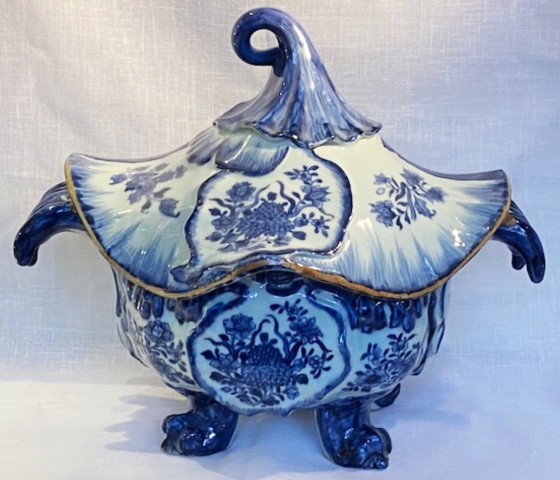BG85
Modelled in the Rococo style, inspired by a European form; the wide oval body raised on four claw-like scroll feet, with two frond handles on either side; the scalloped, 'chapeau Chinois' cover formed into undulating waves, with the curl of an upside-down convolvulus flower for the finial, and raised, inverted fleur-de-lys decoration around the top of the body and the top of the legs, painted in vibrant shades of underglaze blue with a brown-washed border around the edge of the lid, raised cartouches feature on both the lid and body and these are painted with well-detailed matching floral sprays of peonies and other blossoms, interspersed with further floral sprays; the sides of the body and cover also with raised cartouches containing a single blossom, the finial and handles all painted in blue, with line patterns accentuating the ridges of the handles; the cover with a border of shaded blue, the ridges of the scroll feet outlined in blue and filled with line patterns.
Literature
The form of this tureen's cover is referred to as chapeau Chinois due to the resemblance it bears to the straw hats worn by Western chinoiserie figures.
A tureen of similar form but with famille rose enamels was bequeathed to the Minneapolis Institute of Art by Leo A. and Doris Hodroff (accession number: 99.217.433a,b). Also see David Howard and John Ayers, 'China for the West', vol II, pp.552-553, fig 571; also, Michel Beuderlay, 'Porcelaine de la Compagnie des Indes', pp. 52-53, figs. 23-24. See also See also Geoffrey A. Godden, Oriental Export Market Porcelain, London, 1979, p. 134, fig. 34 for a very similar tureen.
An almost identical blue and white tureen is in the Peabody Essex Museum (museum number: E83552.AB. See: Sargent, W. 'Treasures of Chinese Export Ceramics: from the Peabody Essex Museum' pl.49). The author writes that the 'rococo' form of this tureen may have been inspired by a faience model from Germany or Scandinavia. Sargent notes that possible original models include ones made in Hochst, Germany, one 1748 by Johann Gottlieb Rothe, and one made around 1750 by Ignaz Hess. A further possible original was made in 1745, in Strasbourg, by Paul Hannong. Further comparisons have been made between this form and a Mariberg soup tureen in the Axel Springer Collection, dated 1765.

